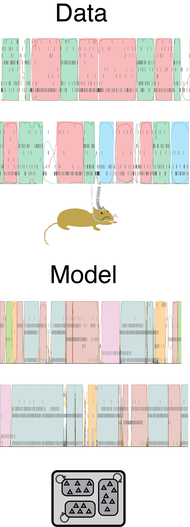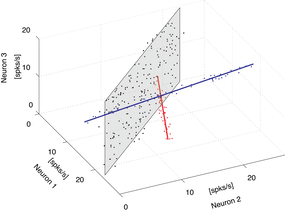Neural dynamics
How do cortical activity complex dynamical patterns emerge from neural populations?
Even in the absence of over sensory stimulations, many areas in the brain are extremely active, generating complex spontaneous activity. We study how collective interactions between large neural populations shape the emergence of collective activity patterns - and how spontaneous activity shapes the response to sensory stimuli.
Even in the absence of over sensory stimulations, many areas in the brain are extremely active, generating complex spontaneous activity. We study how collective interactions between large neural populations shape the emergence of collective activity patterns - and how spontaneous activity shapes the response to sensory stimuli.
Spontaneous and evoked dynamics in taste cortex
|
Single trial analyses of ensemble activity in alert animals demonstrate that cortical circuits dynamics evolve through temporal sequences of metastable states. It is often assumed that the onset of state sequences is triggered by an external stimulus. Here we showed that state sequences can be observed also in the absence of overt sensory stimulation. We discovered that single neurons spontaneously attain several firing rates across different states. This single neuron multi-stability represented a challenge to existing spiking network models, where typically each neuron is at most bi-stable. In a recurrent spiking network model, we showed that each state resulted from the activation of neural clusters with potentiated intra-cluster connections, with the firing rate in each cluster depending on the number of active clusters. When probed with external stimuli, the model predicts the quenching of single neuron multi-stability into bi-stability and the reduction of trial-by-trial variability. Altogether, these results provide a theoretical framework that captures both ongoing and evoked network dynamics in a single mechanistic model.
|
Neural dimensionality during spontaneous and evoked activity
|
The activity of ensembles of simultaneously recorded neurons can be represented as a set of points in the space of firing rates. Even though the dimension of this space is equal to the ensemble size, neural activity can be effectively localized on smaller subspaces. The dimensionality of the neural space is an important determinant of the computational tasks supported by the neural activity. Dimensionality grows linearly with ensemble size, and grows significantly faster during ongoing activity compared to evoked activity. A spiking network model with clustered architecture predicts a characteristic scaling with ensemble size that could be tested in high-density multi-electrode recordings. The theory predicted the existence of an upper bound on dimensionality. The bound is inversely proportional to the amount of pair-wise correlations, and directly to the number of clusters. The theory allows to estimate the dependence of such bounds on the number and duration of trials. Together, these results provide a framework to analyze neural dimensionality in alert animals, its behavior under stimulus presentation, and its theoretical dependence on ensemble size, number of clusters, and correlations in spiking network models.
|

